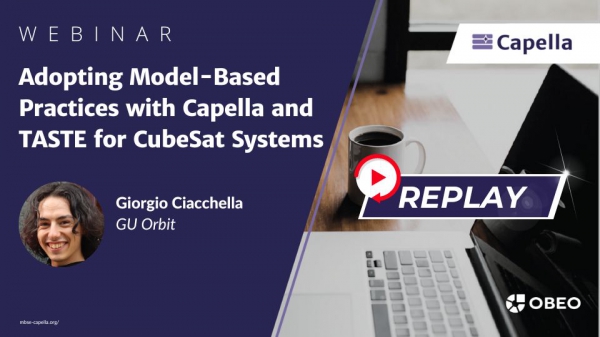Adopting Model-Based Practices with Capella and TASTE for Student-Developed CubeSat Systems

Replay Capella Webinar - June 6th 2024
Adopting Model-Based Practices with Capella and TASTE for Student-Developed CubeSat Systems
In today's transforming industry, Model-Based approaches are often seen as an add-on, further complicating the already complex work of systems engineering and software development. But what if it did not have to be this way?
At GU Orbit, we have adopted the Arcadia method exactly to make the process of engineering complex space systems more accessible to undergraduate students. With its multi-level workflow, repetitive activities, and opinionated semantics enforced by the Capella tool, it effectively guides even inexperienced users in the design of rational systems. Additionally, taking advantage of its semantic similarity to the European Space Agency's TASTE toolchain for embedded software development, we have devised an overarching methodology to rigorously bridge the gap between high-level system specifications and low-level component code.
This Arcadia-based method comprises the entire systems engineering lifecycle in a unified V-shaped model. The design phase is performed in Capella, regularly traversing all main functional decomposition levels. Specific physical-level views are then used to translate the resulting model into TASTE, trivialising the implementation phase down to individual lines of code in the Specification and Description Language (SDL, ITU-T Z.100) and C/C++. Finally, the verification and validation phases are carried out at all levels of abstraction by comparing specific TASTE-generated diagrams, such as State Chart Views and Message Sequence Charts (MSC, ITU-T Z.120), against their Capella-defined counterparts.
In this webinar, we illustrate this method in the context of GU Orbit's student-led development of autonomous nanosatellite avionics, which were successfully demonstrated during an early stratospheric balloon flight.
Presented by:
 Giorgio Ciacchella - Project Manager and Systems Engineer at GU Orbit
Giorgio Ciacchella - Project Manager and Systems Engineer at GU Orbit
Giorgio is a Masters' student of Electronic and Software Engineering at the University of Glasgow, where he leads the local nanosatellite club GU Orbit. During his 3 years of involvement, he has been responsible for the adoption of MBSE practices and their application to the design of the avionics architecture, the development of critical flight software, and their deployment on a successful sounding balloon mission. He is interested in research and development on formal, model-based methods and tools for systems and software engineering, particularly targeting the embedded domain; his first publication (An Open-Source Method for Model-Based Development of Embedded Systems: Experience Report from a CubeSat Student Project) was awarded as the best work in its category at the 2023 International Astronautical Congress.


